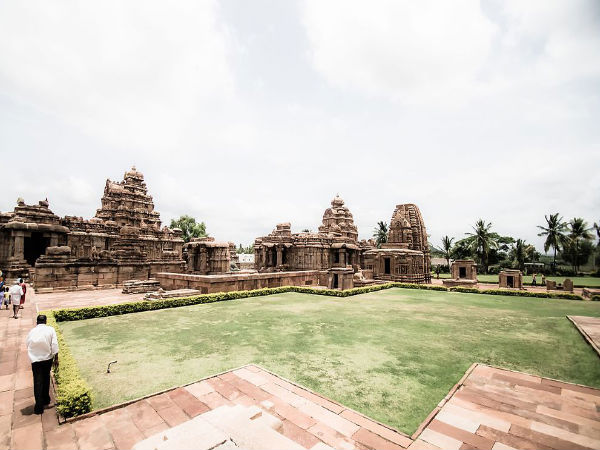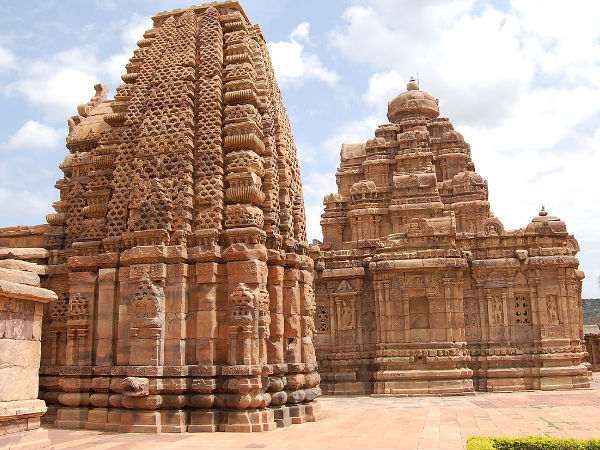Pattadakal or Pattadakallu is situated on the banks of the river Malaprabha. The town is located in the Bagalkot district of Karnataka. It is a testament to the architectural expertise of the Chalukya Dynasty.
It was earlier known as Pattada Kisuvolal, which means City of Crown Rubies. It has been identified by UNESCO as one of the World Heritage Sites apart from Hampi and Badami which are located in very close proximity to Pattadakal.
It also served as the place where the coronation of the Kings took place; hence, Pattadakallu has another meaning, coronation (Pattada) stone (Kallu). The place is home to various temples in both North Indian and South Indian styles of architecture.

PC: Deepak Bhaskari
Getting There
The city is well connected by roads, railways and by air. The nearest airport is Belagavi which is about 180 km from here and several flights operate to Delhi, Bengaluru, Mumbai and Chennai along with other major cities.
Badami, which is located at a distance of 22 km is the nearest railhead. There are trains which operate to major cities such as Bengaluru, Ahmedabad and Solapur, to name a few.
There are several buses which are run by KSRTC and private tour operators which ply regularly from Bengaluru (514 km), Hubli (120 km) and Belagavi (180 km).

PC: Ashwin Kumar
Best Time To Visit
The months from October to March are the best time to visit as the weather remains pleasant and so are the months from July to September.
More About The Place
It is a historical location where the Badami Chalukya kings were crowned as it was considered a holy place by them. The first ruler to be crowned here was Vijayaditya at the beginning of the 7th century AD. It remained the capital of the Chalukya dynasty from the 6th to the 8th centuries.
The Chalukyas constructed many temples here during the 7th and 8th centuries. There are ten temples here, which include a Jain Basadi surrounded by numerous other small shrines and a heavy base which is a fusion of various architectural styles of north India and south India.

PC: P4psk
The temples here reflect the various religious sects that existed here. Four temples were built in the Dravidian style and four in the Nagara style, whilst the Papanatha temple is a fusion of both the styles.
In total there are nine temples dedicated to Shiva and a Jain basadi which was built in the 9th century and was the last temple to be built here. The oldest amongst them is the Sangameshwara temple which was built during the period between 697 and 733 AD.
The largest of all the temples is the Virupaksha Temple which was built between 740 and 745 AD by the Queen of Vikramaditya II to celebrate his victory over Nandivarman, a Pallava King of Kanchipuram.
Major Attractions
1. Virupaksha Temple

PC: Lalithaaaluri
This is the largest temple in Pattadakal and the most popular one amidst the tourists. It was previously known as the Lokesvara Temple, built by Lokamakadevi, the Queen of Vikramaditya II in the 8th century to commemorate the victory of the King over the Pallavas.
The entire temple is filled with delicate carvings and inscriptions. It also houses several beautiful sculptures of various hindu gods and goddesses which are a perfect example of the craftsmanship of those times.
The inscriptions found in the temple throw light on the fact that King Vikramaditya had employed an architect and a team of sculptors down from the South as a medium to express his admiration for the art of the Pallavas.
2. Jain Temple

PC: Dineshkannambadi
The only Jain temple here is an architectural construction in the Dravidian style. It is noted for the several complicated crafted sculptures housed inside it.
The temple dates back to the 9th century and is known for its immense religious and historical significance.
A dilemma still exists over who was the monument's chief patron, as both King Amoghavarsha and his son Krishna II have been named. The temple gathers a lot of visitors who enjoy the artistic excellence.
3. Kashi Vishwanatha Temple

PC: Nithin bolar k
This temple was constructed in the 8th century by the Rashtrakutas. Predominantly constructed in the Nagara style of architecture, it is famous for the several female figurines engraved on the walls.
The monument is a proof of the artistic perfection of the engravings which makes it a must-visit destination in Pattadakal.
4. Galaganatha Temple

PC: Mukul Banerjee
The east-facing temple is located on the banks of the Tungabhadra and dates back to the 8th century. The temple is famous for its exquisite sculpture of Shiva killing a demon called Andhakasura.
The temple is home to an immense Shiva Linga and is known as Sparsha Linga.
Small figurines of Kubera and Gajalakshmi can be found around the sanctum.
5. Sangameshwara Temple

PC: Thushali
This temple is the oldest amongst the group of temples in Pattadakal. The construction of the temple was completed in the year 733 AD by Vijayaditya Satyashraya.
It stands between the Virupaksha and the Galaganatha temples and was earlier known as Vijayeswara temple.
The temple is constructed in the Dravidian style of architecture and is remarkable for its complex and detailed design.
6. Mallikarjuna Temple

PC: Manjunath nikt
The temple was built soon after the completion of the Virupaksha temple. An interesting factor is that it is a miniature of the Virupaksha temple. Both the temples have several similarities in their architecture.
It was built by King Vikramaditya's second queen Rani Trilokyamahadevi to celebrate the victory over the Pallavas.
The temple has several aspects of the Dravidian architecture, which includes a four storied Vimana (Temple Tower) with a circular griva (neck) and shikhara (tower).
The porch houses a beautiful image of Narasimha killing Hiranyakashipu which adds on to the beauty of this structure.
7. Papanatha Temple

PC: Meesanjay
The temple was built in the Vesara style of architecture in the 7th century. The construction initially began in the Nagara style of architecture, but later on, the architects switched over to the Dravidian style as a result of which the temple has elements of both styles.
The ceiling is furnished with notable figures of Shiva and Parvathi along with the Gandharvas and Vishnu. Several carvings of the temple depict various scenes from the Ramayana and the Mahabharatha.
The expertise of the artisans is very much evident in the temple which attracts art and history enthusiasts.



 Click it and Unblock the Notifications
Click it and Unblock the Notifications
























